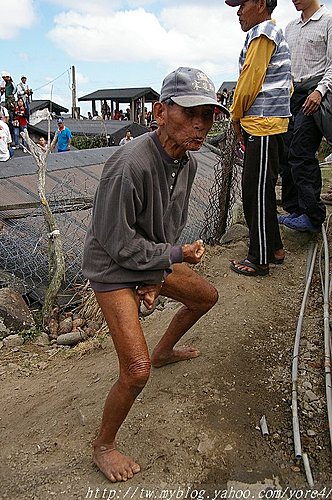
瞪眼怒視,雙手握拳,右手約在胸口下方,保持不動;
左手約在腰際前方,不斷以繞圓圈方式揮動,
聲嘶力竭的吆喝,雙腳用力跺步,揚起塵埃.
吆喝的內容多半為:”叔伯啊(子姪啊),要加油,不要讓人家瞧不起我們”之類的
(請見下方經典動作示範!!)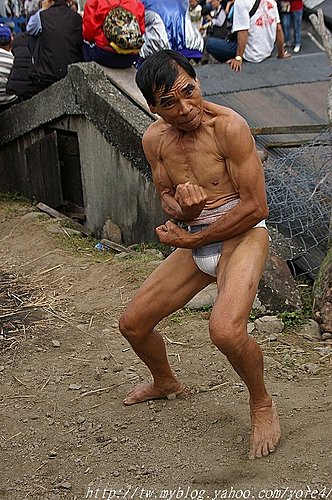
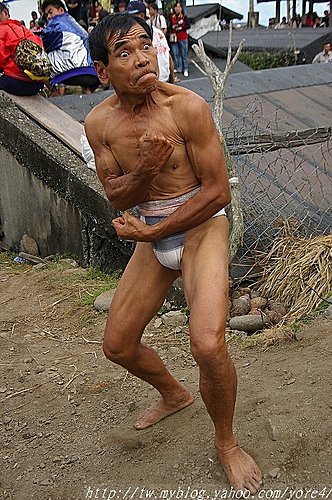
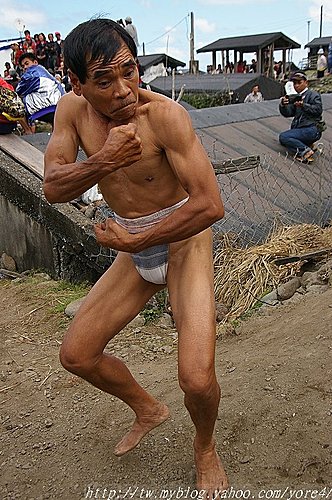
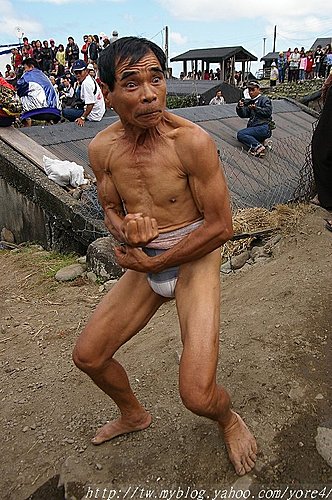
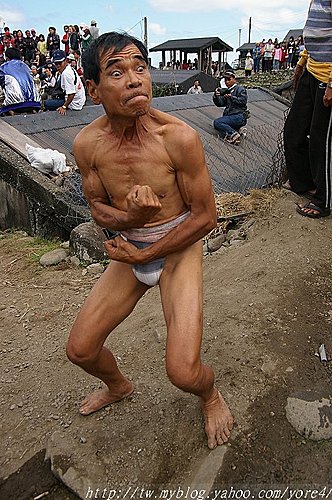
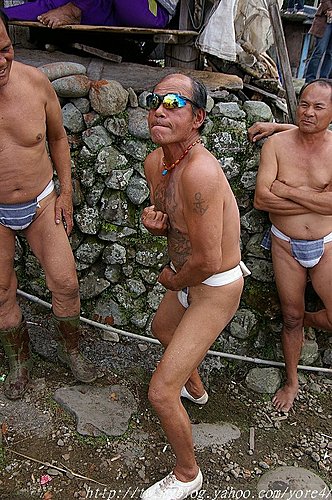
接受到長輩的激勵,而產生了回應的動作.
請大家不要再把蠻阿威解釋為:驅魔動作 了!
蠻阿威在大船下水儀示中,主要的用意是激勵大家的士氣,
讓參與拋船的人,可以因互相刺激(激發腎上腺素分泌),
而產生更大的力量.可以把大船拋得更高更穩. 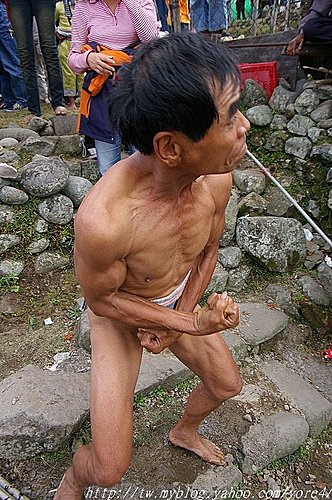
類似一種互尬,
彼此藉著誇張的聲勢以及激昂的情緒動作,
來互相挑起體內 腎上腺素的分泌,
腎上腺素會促使肝糖水解,增加葡萄糖釋出量、刺激脂肪細胞分解脂肪,
增加細胞的能量,讓身體有很多能源來應付危機狀況,
並導致下列狀況:增加心跳速率、血壓升高、
呼吸急促、刺激汗腺分泌、降低內臟血液量,
增加骨骼肌、心臟和腦部的血液量……等。
這些生理機制主要是讓人體能應付突如其來的打鬥或為逃跑作準備
當然,拿來抬十人大船,也是很適合的.
下一次,要和人吵架打架之前,不妨先來一段蠻阿威吧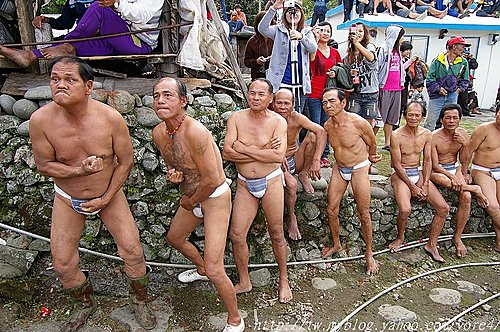
馬上就要接受到刺激的馬讓們,升火暖機,蓄勢待發中.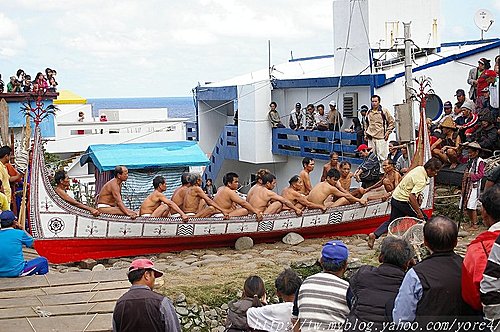
唱完祝福歌了.槳與支架,還有舵,都先取下.由專人隨船送達海邊.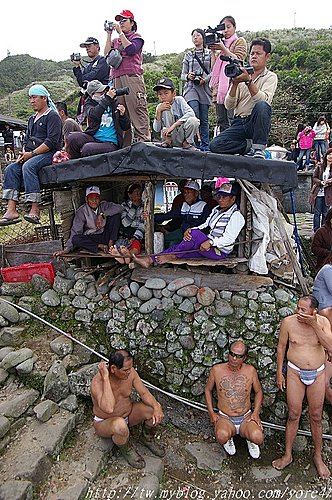
摒氣凝神,拭目以待,最叫人難忘的交響曲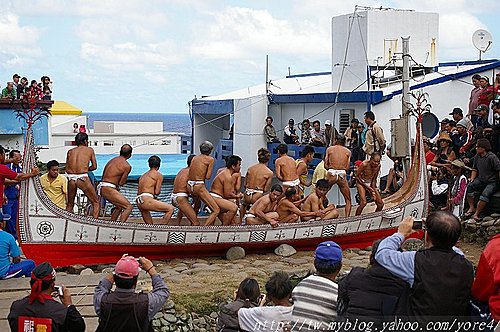
船員直接在十人舟上,發出蠻阿威的信號.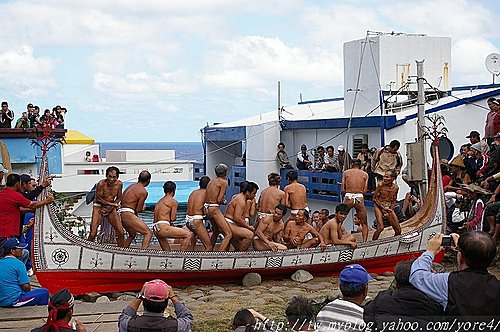
向四面八方的預備隊伍,傳遞出訊息
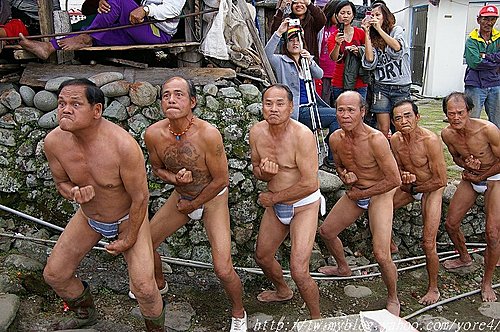
這邊的馬讓們,上緊了發條,發出怒吼,向大船前進.
這次野銀大船下水,共安排三支青壯年隊伍,紛著丁字褲,赤裸著健美的上身.
從三個不同的方向,在蠻阿威的步伐中,大聲吆喝的一步一步向大船邁進.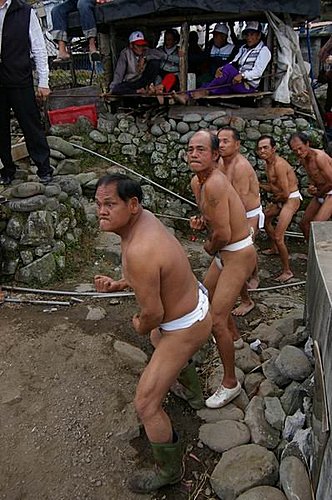
另一方的青年率先抵達大船,完成會合,並與正面到達之隊伍互相激勵士氣↓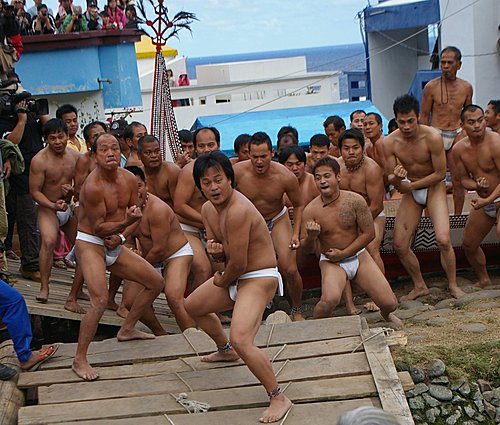
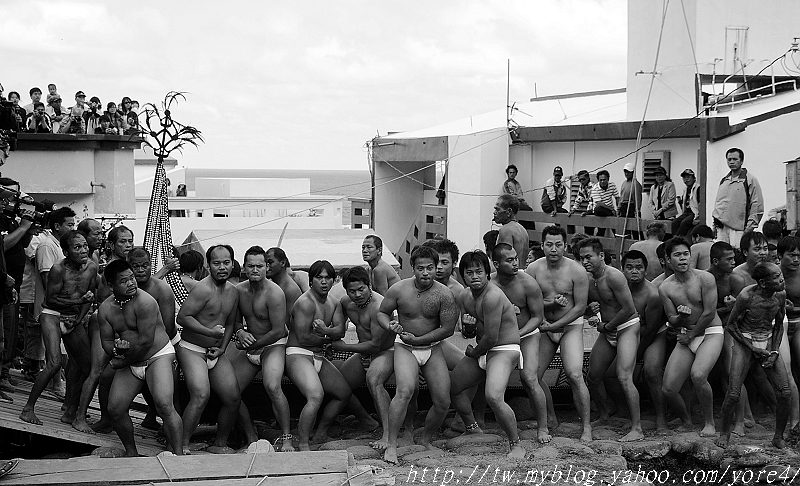
參考資料一:
Manhawey (蠻阿威)
文:謝永泉
每逢蘭嶼反核抗爭、傳統刻紋的(8或10人拼板舟)大船Cinedkeran慶祝下水時;達悟勇士,握拳顫動、咬牙緊唇、怒目相向……的肢體語言。媒體記者紛紛報導說:是驅魔。甚至更荒謬的把Manhawey(蠻阿威)說成驅魔舞(91.5.1聯合報頭條新聞版--【記者:羅紹平】)。
這位羅記者為何解釋達悟勇士在跳驅魔舞?這或許是多數外地人的【誤判】與本地人【誤導】吧!其實傳統刻紋的大船在Manhawey(蠻阿威)「拋船」儀式中,站在船內「僅有一人」走動揮刀者,才是【驅魔】。據悉鬼魂若【滿座】船內,船會變重難拋,故理當在船內驅魔。
Manhawey(蠻阿威)有多角度傳統解讀:
彼此激勵、提振士氣:傳統刻紋的大船Cinedkeran慶祝下水時,讓勇士們奮力齊聲,使船高高拋空。
1.安慰與同情:被人欺侮、敗選、被人誤會受委屈時,親朋好友來安慰。
2.向對方挑釁:面對敵方、對手時,展現不友善,不把人看在眼裡。
3.認同與支持:東清村舉行傳統刻紋的大船Cinedkeran慶祝下水時,喪家在旁Manhawey(蠻阿威),表示若我們沒有喪事,我們一定會參與「拋船」儀式。
Manhawey(蠻阿威)或許還有傳統解釋……。
Manhawey(蠻阿威):過去傳統達悟生活領域中,出現頻率甚高;讓勇士不能抱孩子、讓勇士吃飯必須狼吞虎嚥。蘭嶼達悟被稱是【愛好和平】的民族旗幟,搖搖欲墜。
上述顯見,Manhawey(蠻阿威)並不是【好事】。
Manhawey(蠻阿威)並不是用來【跳舞】。
Manhawey(蠻阿威)是很嚴肅的課題。參考資料2:取自網路:靜宜大學蘭嶼達悟語口語資料典藏網
maneh wey 瞪眼揮拳
謝永泉(Si aman macinanao)採錄
董瑪女記音翻譯
2005-9
3.maneháwey瞪眼揮拳Throwing fists with glaring eyes
o ya asa ta ma-lavat do jía, i-panci tamo a maneháwey
一個 我們 提到 這裡 說 我們 瞪眼揮拳
koan na,
說 他
另外,我們在這裡提到的一件事情是,我們叫它manhawey,
Also, we mention something here that we call manhawey (i.e., throwing fists with glaring eyes),
o maneháwey iya am, no mey-ci-cinedkeran sira, tana
瞪眼揮拳 這 若 建造大船 他們 不論是
ni-mey-ci-cinedkeran sira o tiye-sa ite-tngeh-an a, kaji
建造大船 他們 一些 親族團體 不
da nivatkan do cinedkeran da am, ji dá manehawayi o kma
他們 有雕刻 大船 他們 不 他們 瞪眼揮拳 像
sang,
那樣
關於這個manhawey,當建造大船的時候……,如果一個漁團(親族團)建造了大船,但是沒有雕刻,這艘船不能做manhawey的儀式,
About this manhawey, when you build a big boat……, if a fishing group (family group) builds a big boat without carving, this boat cannot be used for the manhawey ceremony.
o i-paneháwey no tao do pongso ya am, ori am, akmey
瞪眼揮拳原因 人 島上 這 那個 像
i-pa-’agnat so akmey sozi-sozi no tao iya, ta no si to
使提振 像 怒氣 人 這 因 若 萬一 一直
ta mang-onong a, k-angey ta om-’agnat so cinedkeran ito
我們 走 去 我們 抬舉 大船 那個
am, a ikong dang o oy-ówyat ta koan na am, akmey
什麼 那裡 力量 我們 說 他 就像
pa-sozy-in o ka-taw-tao do dang a,
使生氣 本身 那時
島上的人所以要manhawey,是為了提振士氣,使自己處於生氣憤怒的狀態,因為如果要去抬那艘大船的時候,我們會沒有力氣抬船,所以必須先激怒自己(讓自己很生氣的樣子,才有力量抬船)
The reason that people on the island want to throw their fists with glaring eyes is to increase morale, so that they will be in an angry state of mind. When they are going to carry that large boat, they may not have any energy to carry it, so they need to anger themselves first (let them feel very angry so that they have energy to carry the boat).
akman sang o ka-tovang-an a ma-cita a ke-yli-an ta sir(a)
像 那樣 對方 看見 村人 因 他們
or(i) am, i to sira mici-api-apinpín-an sir(a) ori so
那些 就 他們 一隊一隊的 他們 那個
ni-ka-tazak-a-tao-an a, k-angey da mam-rapong rana so
出生的 去 他們 摸
i cínedkeran iya a manehawey,
大船 瞪眼揮拳
在對方的村人也是一樣,他們依自己的年齡層自成一隊,然後一面manhawey,一面向大船前進去摸(圍住)大船,
註:進行manhawwey的儀式時,通常參與manhawey的隊伍(男性)是從大船的兩端稍遠處,逐漸向船漸近,但小船無此儀式,
The village adjacent to us is the same way. They will line themselves up according to age, and as they manhawey, they close in on the large boat.
Note: while performing the manhawey ceremony, the lineup (men) that participates will start from the two sides of the boat and slowly approach it. Smaller boats do not have such a ceremony.
o i-panci ta i-ci-cirawat ta do pongso ya am, o manehawey
說 我們 文化,習俗 我們 島上 這 瞪眼揮拳
iya am, beken-a ma-mozwow so anito, o mian do sahad no
這 不是 驅趕 鬼 在 裡面
cinedkeran or(i) a asa ka tao a mey-pazazewey, no ’agnat-en
大船 那裡 一 人 持長刀者 當 抬/抛舉
da o cinedkeran eya am, amian ori do sahad no cinedkeran a,
他們 大船 這 在 那裡 裡面 大船
no mang-onong a m-angey do morong-an am, m-angey do maoji,
直走 去 船首 去 船尾
ori o ma-mozewow so anito,
那個 驅趕 鬼
我們島上所稱的manhawey這個習俗呢,並不是趕鬼的意思; 當大船被抬著行進的同時,有一個人在船上,手持長刀一下往船首去,一下又往船尾去,他才是主要趕鬼的人,
The tradition that we call manhawey on this island is not meant to chase away ghosts. When the boat is being carried, one person will be on the boat with a sword walking from one end of the boat to the other; he is the main man for chasing away ghosts.
ta no ma-niring sira o anito am, ta si ji mo vozwaw-a sira
因 若 說 他們 鬼 因 若 不 你 驅趕 他們
o anito do sahad no cinedkeran or(i) am, ala ma-réhmet ori,
鬼 裡面 大船 那個 可能 很重 那個
ori o i-ci-cirawat ta do pongso iya a i-panci tamo a
那樣 文化,習俗 我們 島上 這 說 我們
manehawey,
瞪眼揮拳
因為,鬼說,你若不把大船裡的鬼趕走,那艘船抬起來肯定會很重,這就是我們島上有關manhawey的習俗,
Because, ghosts say, if you don’t chase away the ghosts in the big boat, the boat will be very heavy. This is our tradition for manhawey on our island.
最後一張黑白的~張力十足 =D> =D> =D>
回覆刪除感謝分享 :x
謝謝P2哥,達悟朋友的姿勢100分,
刪除人物本身就擁有極大值的張力,我們只是把它拍下來而已.
不過細看老人家和少年郎的架勢.就可以發現,
薑是老的辣,老人的表情與肌肉的糾結,都比年青人美上太多倍了.
歳月與勞動的折磨,讓他們看起來神聖而不可侵.